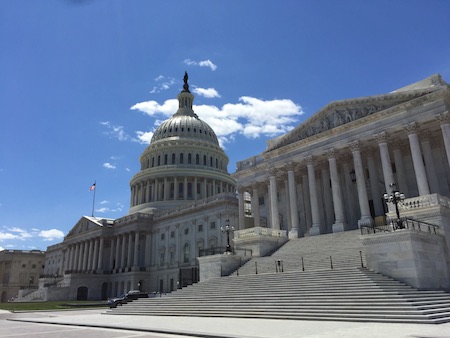“The effects of proposed pending Rule 11 on the patent system will be like putting an additional bullet to a dying man. As far as patent litigation is concerned, the pending rule is intended to deliver what was missed in the AIA: shifting fees from infringers to patent owners.”
 Previously I discussed the History of Rule 11 and how the proposed changes to Rule 11 will impact patent litigation. In this article, I discuss the impacts that pending Rule 11 amendments will have on the Patent System overall.
Previously I discussed the History of Rule 11 and how the proposed changes to Rule 11 will impact patent litigation. In this article, I discuss the impacts that pending Rule 11 amendments will have on the Patent System overall.
The pending rule 11 amendments (H.R. 720 and S. 237) attempts to solve problems in a way similar to the America Invents Act (AIA). The AIA did not focus on root problems in the courts and specific abusive conducts, but created a secondary, wasteful, and redundant processes such as inter partes review (IPR) and post grant review (PGR), and increasing the patent quality standards to make patents more uncertain.
Simply stated, the AIA provides more incentive for infringers to challenge patents. Each IPR proceeding burns additional attorneys fees, expert costs, and other fees. Even worse, if the patent owner is suing other parties, each of the other parties could bring the same or similar challenge, which does happen. Each of the parties can still raise other challenges and other defenses in courts, and there is no real estoppel given that the PTAB does not issue final written decisions on all challenged claims. The design of such IPR processes is based upon pure junk science, and the fairness is consistent with the standard once used by King’s bench. Such proceedings could not achieve any real benefits except that it fosters and intensifies an infringing culture with an end result of destroying the patent system. After the failure of patent rewards has become a chief characteristic of the U.S. patent system, the final impact points of the AIA will be the national economy, national prosperity, and national security.
A fatal flaw in the pending Rule 11 amendments is rooted in common law jurisprudence. Common law courts use what I call “categorization method” in every aspect of the law. A legal definition or a buzzword is defined for a category of conduct such as abusive litigation conduct, and then an indefinite number of factual patterns are fitted against the category. To see how the scope of such a category can be manipulated by courts, one only needs to see how the U.S. Supreme Court once characterized a corporation as person. After such a category is created, the law insists that such a category has accurate boundaries and each case can be decided by fitting its facts against the category. For example, it is assumed that abusive litigation conduct, like patent validity, can be accurately determined. In reality, “abusive litigation conduct” cannot be accurately defined, and simply does not have accurate boundaries. The result in each case would depend upon the judge even though the judge may have to work around a large number of sanctions precedents. Hearings attempted to find precise boundaries for such categories often consume disproportional amounts of judicial resources without achieving real justice. This is why the pending Rule 11 amendment must fail.
The pending Rule 11 amendments will affect patent cases in a special way. The pending rule poses very high risks on patent owners, but fails to provide any method for addressing factual uncertainty inherent in patent suits. Adverse impacts of the pending rule in patent cases are obvious to patent practitioners and sophisticated patent owners. This would force sophisticated patent owners to give up meritorious claims, thereby resulting in failure of patent rewards. Patent owners, who are undeterred by the pending rule, may face massive sanctions in courts. Each time, when a patent owner cannot realize a constitutionally promised reward, the story will become a statistical proof of the failed patent rewards. Each sanction order entered against a patent owner will become the proof of injustice in the patent system. After a few sanctions cases are reported, sanctions will become the biggest threat to all patent owners, and discourage them from enforcing their patent rights in courts. The pending rule will further reduce delivered patent reward size for the whole patent system. Therefore, the final impact point of the pending rule is more damages to the patent system.
To understand the impact of the pending Rule 11, one should see how the overall size of delivered patent rewards affects the performance of patent systems in various nations. I will propose two inventor population concepts for convenience. For a nation, the number of people who would try to invent is anywhere from 0% to the theoretical maximum (100%) of the population; and the number of people who could make an invention in a given time period is from 0% to less than a fraction of one percent of the population. U.S. patent rewards is only right to exclude, which includes the right to sue for damages. If patent rewards cannot be delivered, the would-try-inventors will be zero and would-be-inventors will also be zero (except rare voluntary and hobby inventors). Patent reward failure has the same effect of providing no patent reward. If the Congress conducts a study to examine economical performance for all major common law nations that provided no reward (thus with zero % inventors), it should immediately see serious consequences.
The danger of patent reward failure is clearly reflected in the anti-patent histories of many common law nations. I will summarize the course in the following stages: inventions created national prosperity, powerful people who had been hindered by patents started anti-patent movements, anti-patent movements crippled patent systems, and crippled patent systems fatally damaged national economy. Rewards are good for national economy, exclusive invention rights are bad for powerful individuals, but forfeiture of patents and non-performing patent system were absolutely the worst to any nation. Several common law nations that had experienced anti-patent movements still chose to have a patent system after they had suffered serious damages.
The failed reward is also fully reflected in the histories of the China in two different periods (1949-1984 and 1985-present), China’s economy has expanded by 50 to 100 times with the biggest jumps starting five years after enactment of its first patent law. It is also fully reflected in the Soviet/Russian technological landscape: 20 rubles rewards did not promote its economy, but unlimited rewards in governmental technologies led to its military superpower. It is also fully reflected in comparative economical performance data between South Korean and North Korean, or similar data between West Germany and prior East Germany. Changes to Rule 11 will create a patent reward failure or create negative rewards in some cases. So, its impact is self-evident.
One cannot use annual patent application and patent numbers to show the performance of the U.S. patent system. Such data does not reflect the true performance of the U.S. patent system because the data contains mainly foreign applications and U.S. corporation applications that are filed for controlling U.S. market. Anyone should see a large number of problems of the U.S. patent system by studying the compositions in U.S. patents, ownership of patents, commercial activities revolving patents, patent reward realization, potential impacts of patented inventions, investment opportunities for patented technologies, and patent abandonment statistics. The U.S. patent system was most probably the best in the world in 1930 because most nations did not reward inventors. However, the U.S. patent system started degrading rapidly long before the enactment of the AIA, at least if reward delivery is used as the key performance criterion. Neither sanctions nor outrageous attorney fees will significantly affect routine product improvement activities and patenting activities of foreign corporations in the U.S.
Fee shifting caused by pending Rule 11 amendments in patent cases will become a prohibitory deterrence for inventive activities outside corporate buildings. No individual inventors will spend time and money to invent, contribute their inventions to the public, and then face the risk of being liable under pending Rule 11. The pending Rule 11 would deter not abusive litigation conducts, but would-try-inventors from engaging in inventive activities. It only takes a few major sanctions that would cause the would-try-inventor population from whatever current tiny value to 0.00000%. I hope that the Congress can see the severe impacts of the pending Rule 11 on the U.S. technological future.
The U.S. patent system was primarily responsible for prosperity that Americans have enjoyed for generations. The Congress should avoid doing more to damage the U.S. patent system. Representatives must treat the patent system as a whole system, put national interest ahead of their constitutes’ interest, and address specific problems wisely. The Congress should not repeat the mistakes that were caused by anti-patent movements in other nations. When a fatal mistake was made in patent policies, damages to the patent system cannot be undone. Damaged trust in the patent system, lost inventor population, changed commercial practices, distorted technological landscape, and bad patent composition will harm the nation for years to come. When national economy is crippled, all citizens and residents in the U.S. will suffer from the consequences.
The effects of proposed pending Rule 11 on the patent system will be like putting an additional bullet to a dying man. As far as patent litigation is concerned, the pending rule is intended to deliver what was missed in the AIA: shifting fees from infringers to patent owners.

![[IPWatchdog Logo]](https://ipwatchdog.com/wp-content/themes/IPWatchdog%20-%202023/assets/images/temp/logo-small@2x.png)

![[Advertisement]](https://ipwatchdog.com/wp-content/uploads/2024/04/Patent-Litigation-Masters-2024-sidebar-early-bird-ends-Apr-21-last-chance-700x500-1.jpg)

![[Advertisement]](https://ipwatchdog.com/wp-content/uploads/2021/12/WEBINAR-336-x-280-px.png)
![[Advertisement]](https://ipwatchdog.com/wp-content/uploads/2021/12/2021-Patent-Practice-on-Demand-recorded-Feb-2021-336-x-280.jpg)
![[Advertisement]](https://ipwatchdog.com/wp-content/uploads/2021/12/Ad-4-The-Invent-Patent-System™.png)







Join the Discussion
One comment so far.
Night Writer
September 29, 2017 08:42 pmSeems like we are going to have to have an innovation fail. I wonder. Maybe all innovation will go off shores and we will just become the Taiwan of the world.
Going to be a wild ride.